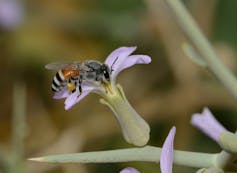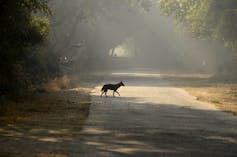Habitat loss is the leading cause of biodiversity loss worldwide. Depending on their size, animals need a given amount of area to be able to find enough resources to maintain viable populations. But once the area of available habitat goes below a certain threshold, populations are no longer viable and species go locally extinct.
Another consequence of area loss is that the remaining habitat patches – and the populations of species that still live in them – become fragmented. Patches of pristine habitat become isolated by a “matrix” of inhospitable areas, preventing the movement of species between places where they could live.
This loss and fragmentation also affects biodiversity inside remaining patches through “edge effects”. These are changes in natural communities at the boundaries (edges) of distinct habitats in the same ecosystem. For example, there may be abrupt changes in species abundance at the edges, due to drastic changes in environmental conditions such as temperature or humidity.
PJeganathan/Wikimedia, CC BY-SA
While there is debate over the relative impacts of loss and fragmentation on biodiversity, we know that it can have longlasting effects on everything from the amount and persistence of species within different areas, to community composition. And now our newly published research has shown that loss and fragmentation changes the way species within biological communities actually interact well before extinctions are detected. This has a serious effect on the stability of whole communities.
Interactions extinction
As early as 1974, leading ecologist Daniel Janzen identified that habitat destruction brings about “the extinction of ecological interactions”. Janzen observed that these relationships between species (which range from interactions between prey and predator to mutually beneficial ones such as those between plants and the animals that pollinate them) are lost independently, and in a much more concealed way, than loss of species.
For example, when habitat is fragmented, it becomes difficult for large predators to reach distant patches for hunting. This means that predator-prey interactions can weaken in more isolated areas. And this can have secondary effects on the community by enhancing prey species or more local, smaller predators.

Gideon Pisanty (Gidip) גדעון פיזנטי/Wikimedia, CC BY-SA
Since Janzen’s work, researchers have been looking for recurrent patterns in how networks of ecological interactions respond to habitat destruction. These networks link all species interactions within communities into a single web. For example, in a food web, when a predator eats a prey, this can have consequences for the resources used by the prey.
Studies in this area have revealed that ecological networks react to habitat loss in different ways, depending on the type of interaction. While networks of mutualistic interactions tend to break up into smaller networks, food webs tend to contract into a single smaller network. Mutualistic interactions also tend to become weaker (the species rely on each other less), while feeding relationships are stronger under habitat loss.
But while this research has confirmed that habitat destruction deeply influences the way species interact, until now we have lacked a full understanding of the effects of habitat loss on community stability. Similarly, we have not known to what extent community responses change depending on the nature of habitat loss.
Modelling habitat loss
For our study, we looked into these issues of community stability and response using a mathematical representation of an ecological system. This model simulates interactions and changes in species populations through time in a range of different landscapes – from pristine continuous habitats to highly fragmented habitats. These are based on what areas subjected to habitat loss look like in the real world.

Nature Communications, CC BY
Our results suggest that habitat loss affects community stability, through changes in ecological interactions, by altering the abundance and spatial distribution of species through time. And, as noted above, we also found that these ecological interactions change well before species extinctions. Limited animal movement between remaining habitats translates into negative changes in things like eating patterns, which in turn affects the way population sizes change through time and across space.
We also found that the specific way in which habitat is destroyed is a key determinant of the community responses to habitat loss. When habitat becomes more fragmented, it makes communities more stable due to a weakening of ecological interactions. But when habitat is lost in adjacent areas – leading to less fragmentation – this makes populations less stable due to stronger species interactions in the remaining suitable area. In fragmented landscapes, predators have a harder time finding prey, which decreases their interactions. Less fragmented landscapes, on the other hand, make predators interact more often with their prey because they are all confined to a reduced area.
By understanding how habitat loss affects interactions between different species in different environments, we can begin to see the true depth of humans’ impact on the natural world. It is not just loss of single species that should be of concern but rather the way that whole communities are affected by human-induced threats. Our findings suggest that biodiversity strategies need to take into account community interactions, as well as the shape of habitat loss, in order to better preserve future biodiversity.
Credit: Source link




